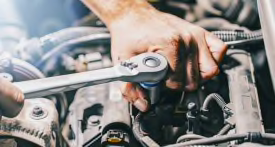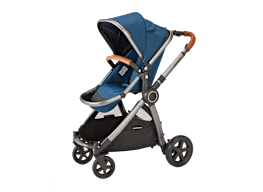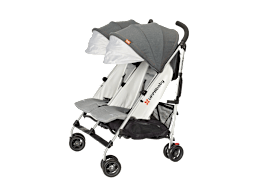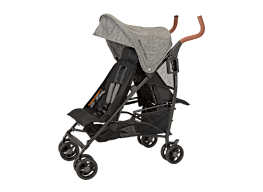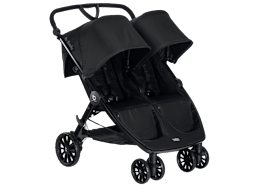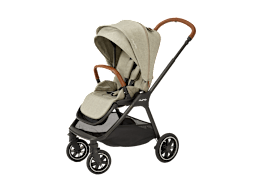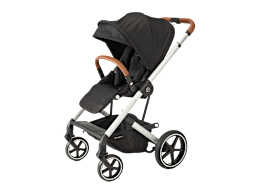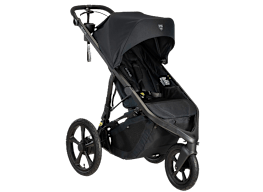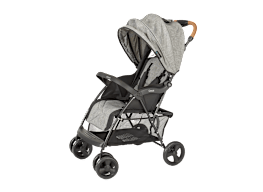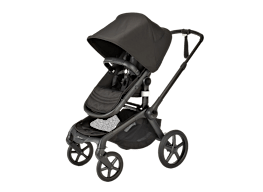Best Strollers of 2023
These top-performing strollers are safe, sturdy, agile, and easy to use, according to Consumer Reports' rigorous tests.
When you shop through retailer links on our site, we may earn affiliate commissions. 100% of the fees we collect are used to support our nonprofit mission. Learn more.
A stroller’s job is to make your life easier: You should be able to fasten your little one in without fussing with complicated straps, push the stroller without difficulty, and rest assured that your child is safe inside it even on a bumpy road.
Picking a stroller, though, can feel a little complicated. You don’t want a stroller so sturdy that it’s heavy to maneuver, but you also don’t want one so light that it doesn’t support your child.
That’s why CR’s stroller experts, led by engineer Joan Muratore, designed tests that take every aspect of a stroller into account to figure out which ones are safest, easiest to use, and most comfortable for both you and your child. All that’s left is for you to pick the stroller that addresses your personal preferences and needs.
Factors to Consider
Two things are non-negotiable when it comes to strollers: They should be safe for the child and a breeze to use for the adult. Beyond that, the right stroller depends on the child’s age and development, your budget, and your lifestyle—so you’ll want to pick a stroller with features that address your needs. "There’s no one ‘best’ stroller," says Muratore.
To find your best stroller, start by zeroing in on your ideal type. In our lab, we categorize strollers according to the following:
- Traditional strollers: These all-purpose strollers are designed with leisurely strolls in mind. Expect adequate storage, a seat that reclines, and other convenient features.
- Umbrella strollers: Named for the way they look when collapsed, they’re lightweight, a cinch to fold, and easy to store for quick errands around town.
- Double strollers: These strollers have two seats, either side-by-side or one behind the other, to accommodate two tots.
- Travel systems: These strollers come with a car seat that can clip into both the stroller and your car. Brands bundle the car seat with the stroller, though you don’t have to buy the system as a package from the same brand—many car seats are compatible with multiple stroller brands, and vice versa.
- Jogging strollers: Also known as a baby jogger, a jogging stroller should handle smoothly for both child and parent on a run. Don’t use these with infants under 6 months old—wait until your child is old enough to sit upright to jog with them.
- Car-seat-carrier strollers: These aren’t complete strollers themselves but merely frames that accommodate a car seat that snaps in.
How We Pick the Best Strollers
The strollers in our comprehensive ratings come in a range of shapes, sizes, and prices. Some have a lot of extra features—like ample storage, cup holders, reversible seats, and more—while others are sleek and minimalistic. But those that top our list exceed our expectations in terms of the basic criteria that all parents demand in a stroller. Here’s what our best strollers have in common:
- They keep your child safe. All our recommended strollers meet federal safety requirements. They’re also sturdy and have brakes that you can trust.
- They’re highly maneuverable. Whether you’re traversing unpaved roads or zigzagging through crowded supermarket aisles, our top picks are easy to push and handle the terrain with ease.
- They’re easy to figure out. No one wants to be stuck frantically trying to fold up a stroller to board a bus or struggling to tighten straps on a squirmy child when late for an appointment. Our favorite models are simple to use—because parenting itself is hard enough.
How Consumer Reports Tests Strollers
CR has tested dozens of strollers in our Yonkers, N.Y., lab and put each through its paces, evaluating it for safety, ease of use, and maneuverability.
To assess safety, Joan Muratore and other CR test technicians subject each stroller to tests patterned after the Consumer Product Safety Commission (CPSC) and the American Society for Testing and Materials (ASTM) standards. Depending on the test and the stroller, we use either an infant dummy (a standard design that simulates a 12-month-old child weighing about 17.5 pounds) or a weighted bag filled with 30 to 90 pounds of steel shot to simulate a child. We conduct an incline test to ensure that a stroller’s harness will keep a child securely in the seat on a hill, and an impact test to ensure the structural integrity of a stroller’s frame in the event of an accident. CR also conducts stability and braking tests, which involve engaging the stroller’s brakes and pulling the stroller from different directions to ensure the brakes can keep the stroller in place up to a certain amount of force. When we discover a stroller that’s unsafe, we make sure consumers know about potential dangers.
To evaluate ease of use, panelists perform a range of assessments and rate their experience. They lift and carry it, fold and unfold the stroller, adjust the safety harness, adjust the backrest, engage the wheel brakes, and (if applicable) remove and install the car seat into both the stroller and a car.
To assess maneuverability, testers navigate each stroller—loaded with a 30-pound bag of steel shot—through an S-curve test course, steering it between cones and over obstacles that simulate curbs, grass, mulch, and tree roots.
In our stroller ratings, we also note features like storage options, whether you can fold up the stroller with one hand, and whether the stroller can stand on its own when folded. We even indicate which strollers satisfy strict size requirements at Disney theme parks.
If you’re just starting your stroller search, check out CR’s Stroller Buying Guide. CR members can access test scores and all the details on our top picks, below, as well as in our comprehensive ratings of more than 75 strollers we’ve tested in our labs.
